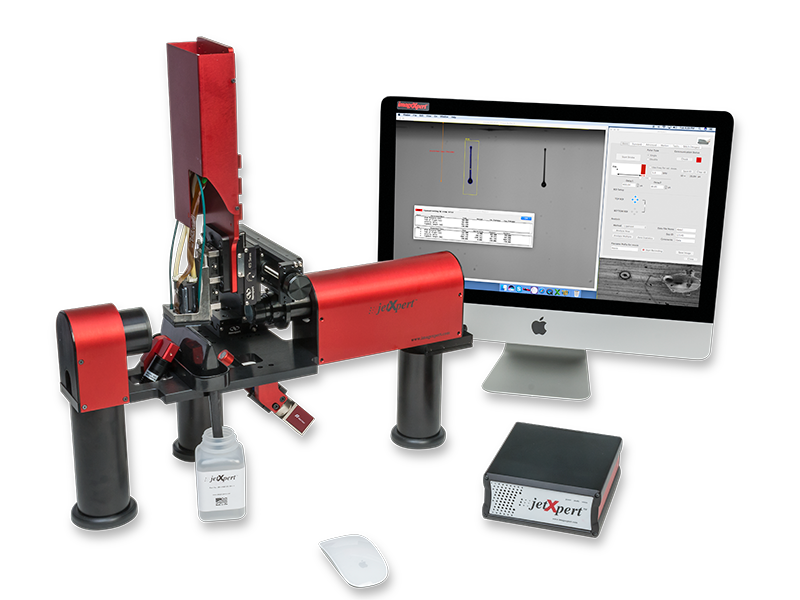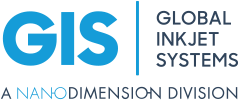Since 1989, ImageXpert Inc. has been combining software and hardware into systems for part and print quality assessment using its expertise in machine vision, image quality analysis, imaging science, and systems integration. 12 years ago, ImageXpert developed its JetXpert line of industrial inkjet and micro dispensing drop watchers and sample printing rigs. These offered the capability to evaluate printhead and print fluid compatibility to ensure that the print quality is optimised for an application. GIS, as the largest independent supplier of industrial printhead electronics, is proud to have been working with the market leader in drop watching since 2011, with the partnership becoming much closer over the last five years.
Fluid manufacturers and machine builders alike have seen the advantage of being able to evaluate printheads and inks in a flexible, robust system that mimics the results of their customers’ printers without all of the overhead. One particular benefit is the ability to easily change printheads, as several printheads may need to be evaluated to find the one offering the best print quality. “Because so many of our customers are in an R&D phase and testing lots of different heads, GIS drive electronics are our go-to choice for our systems” says Kyle Pucci, Applications Engineering Manager at ImageXpert. “They support a wide range of heads and they have made the electronics, cabling, and software so uniform across the board, that our customers can change from one printhead model to another in minutes without having to rewire everything and learn a new platform. When a new printhead is released to the market, they can easily add it to their system and start development because we know GIS will support it. It really aligns well with what we try to accomplish with our JetXpert systems – one uniform platform that will easily work with any printhead.”

Combining the understanding of ink flight profiles with how the ink drops react when landing on the substrate is important to print quality. By integrating the JetXpert drop watcher into a printing station, customers can rapidly evaluate industrial print system setups in an almost real-world environment, with visual results that can be seen and then adjusted quickly. “One thing that is key to making the R&D systems comparable to production is flexibility, so one system can be configured to match any one of hundreds of different printers,” Pucci adds. “The number of heads, print speed, substrate, curing method, etc. all vary from one application to the next, and our customers want control over all of it. GIS drive electronics have an incredible amount of access to printhead parameters and are flexible enough to do pretty much whatever you need them to, organised in a way that is easy enough to adjust on the fly in an R&D environment. Combining the most modular dropwatcher with the most modular drive electronics allows our customers to accomplish some pretty cool things.”
 Another responsibility of the printhead drive electronics is the control of the waveform being sent to the printhead. “Optimisation of inkjet waveforms is an extremely common use for our equipment,” Kyle Pucci continues, “so much so that we would consider it to be one of the pillars of inkjet research for fluid, printer, and printhead developers alike. Most of our customers are at the cutting edge of new inkjet technology, where every aspect of the system has to be precisely tuned in order for the application to be met. Manufacturers’ default recommended waveforms often aren’t fine-tuned enough to their specific needs, so these developers are looking for a fast, easy way to make improvements to these waveforms so they will perform better in their exact application. We’ve built upon GIS technology to make this possible.”
Another responsibility of the printhead drive electronics is the control of the waveform being sent to the printhead. “Optimisation of inkjet waveforms is an extremely common use for our equipment,” Kyle Pucci continues, “so much so that we would consider it to be one of the pillars of inkjet research for fluid, printer, and printhead developers alike. Most of our customers are at the cutting edge of new inkjet technology, where every aspect of the system has to be precisely tuned in order for the application to be met. Manufacturers’ default recommended waveforms often aren’t fine-tuned enough to their specific needs, so these developers are looking for a fast, easy way to make improvements to these waveforms so they will perform better in their exact application. We’ve built upon GIS technology to make this possible.”
Pucci adds “GIS drive electronics are the only ones that we’ve come across that are flexible enough to let us combine our software and image capture in a single script to automatically optimise the waveform, which we call XSweep. They allow TCP/IP-level control of the waveform parameters, which lends itself towards testing a lot of different waveforms in an automated and organised way. All the user has to do is enter of list of values that they would like to test for a particular waveform parameter, and then the software takes over with jetting, image capture, and data analysis for each of the waveforms generated. It makes a complex topic like waveform optimisation a little more accessible and automated for new or expert users alike.”
To be dynamic in its offering, ImageXpert needed a drive electronics partner they could count on. “We are always pushing ourselves to deliver systems faster, because that’s what customers want, and it really helps when we know that GIS can move fast, deliver as promised, and is there to support us. When we are experimenting with a new feature or capability on our systems, GIS is always all-in with helping us figure out how to make it happen,” Pucci concludes. “ImageXpert has a really good reputation for customer support, and a large part of this is from GIS on the back end who is helping us along the way. Their level of support is rare to see, and together we make for some very happy customers. We are glad to have GIS as a key technological partner.”

